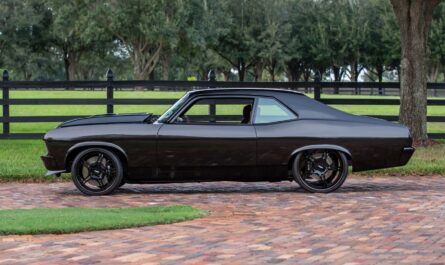The Fiat 600 Multipla is a compact MPV (Multi-Purpose Vehicle) produced by the Italian automaker Fiat from 1956 to 1969. Amazingly, Fiat kept this strange little people carrier in production for more than a decade. The Fiat 600 Multipla was based on the Fiat 600 platform and was designed as a versatile family car with a spacious interior.
1. Design
Exterior
The Fiat 600 Multipla had a boxy and utilitarian design, characterized by straight lines and a compact overall shape. It featured a two-box design, with a separate compartment for the engine and the passenger cabin. The front end had a rounded appearance with a large windshield and a prominent Fiat badge on the front grille.
-1686211503x1024.jpg)
Body Style
The Multipla was a small MPV, featuring a short wheelbase and a tall height to maximize interior space. It had four doors, including two front doors and two rear “suicide” doors that opened in the opposite direction. The rear doors were hinged at the back, allowing easy access to the second-row seats.
-1686211543.jpg)
Windows
The Multipla had generous window areas to enhance visibility. It featured large side windows for both the front and rear passengers, including the distinctive “clamshell” windows that opened upward in a split configuration.
-1686211886.jpg)
Interior
The interior of the Fiat 600 Multipla was designed with practicality and versatility in mind. The front seat was a bench seat, accommodating three passengers, including the driver. The second row had individual seats that could be folded down or removed to create more cargo space. The rear seats were also reversible, allowing passengers to face each other.
-1686211574x1024.jpg)
Chrome Accents
The Multipla featured chrome accents on various parts, including the front grille, door handles, and trim pieces. These chrome details added a touch of elegance to the overall design.
-1686211902x1024.jpg)
Evolving Design
Over the years of production, the Fiat 600 Multipla underwent some design changes. The later models, such as the Fiat 600D Multipla, featured updates like larger windows, a revised front end, and improved interior comfort.
-1686211597.jpg)
2. Engine
Displacement
The engine had a displacement of 633cc (0.6 liters). It was a small engine designed for fuel efficiency and compactness.
-1686211619x1024.jpg)
Engine Type
The engine was an inline 4-cylinder configuration. Each cylinder had a bore (diameter) of 58 mm and a stroke (piston travel) of 56 mm.
Valvetrain
The engine used a single overhead camshaft (SOHC) design with overhead valves. It had two valves per cylinder, allowing for intake and exhaust gas flow.
Fuel System
The engine used a carburetor for fuel delivery. The carburetor was responsible for mixing the air and fuel in the correct proportions before combustion.
-1686211665.jpg)
Ignition System
The ignition system of the Fiat 600 Multipla engine was a traditional distributor-type system. It used a distributor, ignition coil, and spark plugs to ignite the air-fuel mixture in the cylinders.
Cooling System
The engine had a water-cooling system to regulate its temperature. It used a radiator, coolant, and a water pump to circulate coolant through the engine and dissipate heat.
-1686211691x1024.jpg)
Transmission
The engine was paired with a 4-speed manual transmission. The transmission allowed the driver to shift gears manually and transfer power to the rear wheels.
3. Performance
Engine Power
The Multipla was equipped with a 4-cylinder, water-cooled engine with a displacement of 633cc. It produced around 22-30 horsepower, depending on the specific model and year. The power output was relatively low, but it was sufficient for city driving and moderate speeds.
Acceleration
The acceleration of the Fiat 600 Multipla was not particularly fast, given its small engine and weight. It could typically reach 0 to 60 km/h (0 to 37 mph) in around 30-40 seconds. It was not designed for high-performance driving but rather for practical transportation.
-1686211747.jpg)
Top Speed
The Fiat 600 Multipla had a top speed of around 65-75 mph (105-120 km/h), depending on various factors such as engine tuning, aerodynamics, and payload. It was primarily designed as a compact family car for urban and suburban use, rather than for high-speed driving.
-1686211761x1024.jpg)
Fuel Efficiency
The Multipla was known for its excellent fuel efficiency, which was one of its key advantages. With its small engine and lightweight construction, it achieved impressive mileage. The exact fuel consumption would vary depending on driving conditions and driving style.
-1686211775.jpg)
4. Cultural Significance
Practicality and Versatility
The Multipla was one of the first compact multi-purpose vehicles (MPVs) or minivans. It offered seating for up to six passengers in a compact form, making it highly versatile for families and commercial use. Its unique design and practicality made it an iconic choice for taxi services, small families, and businesses.
-1686211789.jpg)
Symbol of Economic Growth
The Fiat 600 Multipla was introduced during a period of post-war economic recovery and growth in Europe. The Multipla’s compact size, fuel efficiency, and accessible price made it attainable for a broader range of people.
-1686211809x1024.jpg)
Iconic Italian Design
The Fiat 600 Multipla was designed by Dante Giacosa, an influential Italian automotive designer. It featured a distinctive and charming design with rounded shapes and a forward-leaning stance.
-1686211825.jpg)
Popularity and Long Production Run
The Fiat 600 Multipla enjoyed significant popularity during its production years. Its success can be attributed to its compact size, practicality, and affordability. The fact that it was in production for over a decade, from 1956 to 1969, further demonstrates its cultural significance and sustained appeal.
-1686211840.jpg)
Cinematic and Cultural References
The Fiat 600 Multipla has been featured in various movies and cultural references, further enhancing its cultural significance. For example, it appeared in the classic Italian film “Roman Holiday” (1953) starring Audrey Hepburn
-1686211856.jpg)


